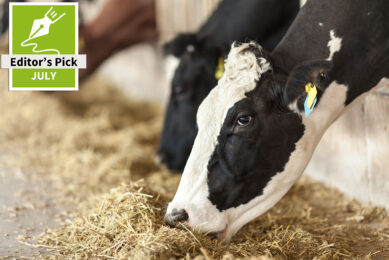Research: Ruminal pH regulation and nutritional consequences of low pH
Combined Dutch/US/Spanish/Canadian research evaluated pH modulation in cattle and the effect on volatile fatty acids and lactic acid in the rumen.
Volatile fatty acids (VFA) and lactic acid can build up in the rumen and reduce ruminal pH.
Low ruminal pH for prolonged periods each day can affect feed intake, microbial metabolism and feed digestion, and has also been related to inflammation, diarrhoea and milk fat depression.
The paper considers aspects of pH regulation, as well as the effects of ruminal pH on rate of substrate degradation and on the profile of VFA available for absorption.
Removal of VFA from the rumen by passage in the liquid phase and by absorption through the rumen wall are major processes that influence ruminal pH.
The buffering capacity (BC) of rumen fluid is variable and is generally assumed to depend primarily on bicarbonate.
Bicarbonate-dependent absorption is not just a primary absorption pathway of VFA but can also secrete bicarbonate at a capacity equal to that from saliva, thus removing protons from the rumen by neutralization.
In addition, the inherent BC of the diet is involved in pH regulation, largely explained by the cation exchange capacity of feedstuffs.
Empirical models to predict ruminal pH have had limited success. The inclusion of dietary characteristics in those models is needed to improve prediction accuracy.
Representations of the effect of pH on fibre degradation adopted in models of ruminal function differ widely and include linear decline, saturation-type and sigmoidal relationships.
In comparison with pH effects on degradation of fibre in sacco, most representations tend to overestimate the inhibiting effect of pH.
Because the products of fibre hydrolysis are a major source of energy for microbial growth in the rumen, proper understanding and representation of fibre degradation at low pH is vital to predict microbial protein supply and VFA production satisfactorily.
Variation in VFA profile is associated with variation in methane production, nutrient partitioning and milk composition.
Various ruminal bacterial species have been observed to shift pathways in response to changes in pH while fermenting the same substrate.
Mechanistic rumen models have adopted VFA stoichiometric coefficients related to type of substrate present in the feed or fermented in the rumen, but the majority of models do not include the effect of pH on VFA profile.
Conclusion
Ruminal pH is a major determinant of the profile of nutrients available for absorption.
Shifting focus to factors other than salivary bicarbonate secretion will aid in better understanding ruminal pH regulation.
Improved models to predict effects of ruminal pH on microbial metabolism and VFA profile will enable further optimization of dairy cow nutrition.











